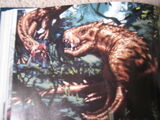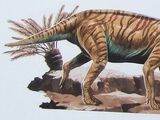Synapsids (Greek, 'fused arch'), synonymous with theropsids (Greek, 'beast-face'), are a group of animals that includes mammals and every animal more closely related to mammals than to other living amniotes. They are easily separated from other amniotes by having a temporal fenestra, an opening low in the skull roof behind each eye, leaving a bony arch beneath each; this accounts for their name. Primitive synapsids are usually called pelycosaurs or pelycosaur-grade synapsids; more advanced mammal-like ones, therapsids. The non-mammalian members are described as mammal-like reptiles in classical systematics; they can also be called stem mammals or proto-mammals. Synapsids evolved from basal amniotes and are one of the two major groups of the later amniotes; the other is the sauropsids, a group that includes modern reptiles and birds/dinosaurs. The distinctive temporal fenestra developed in the ancestral synapsid during the Late Carboniferous (Pennsylvanian epoch) period, eight million years after reptiles first evolved.
Synapsids were the largest terrestrial vertebrates in the Permian period, 299 to 251 million BC, although some of the larger pareiasaurs at the end of Permian could match them in size. As with other groups then extant, their numbers and variety were severely reduced by the Permian–Triassic Extinction Event. By the time of the extinction at the end of Permian, all the older forms of synapsids known as pelycosaurs were already gone, having been replaced by the more advanced therapsids. Though the dicynodonts and Eutheriodontia, the latter consisting of Eutherocephalia (Therocephalia) and Epicynodontia (Cynodontia), continued into the Triassic period as the only known surviving therapsids, archosaurs became the largest and most numerous land vertebrates in the course of this period. The cynodont group Probainognathia, which includes Mammaliaformes, was the only synapsids who outlasted the Triassic. After the Cretaceous–Paleogene Extinction Event, the synapsids (in the form of mammals) again became the largest land animals.
The only extant synapsids today are mammals.
All items (13)



















